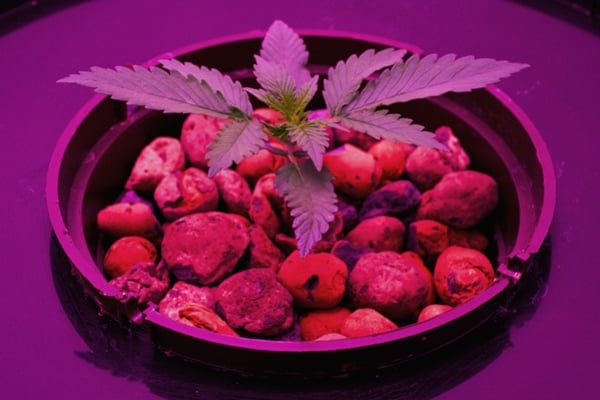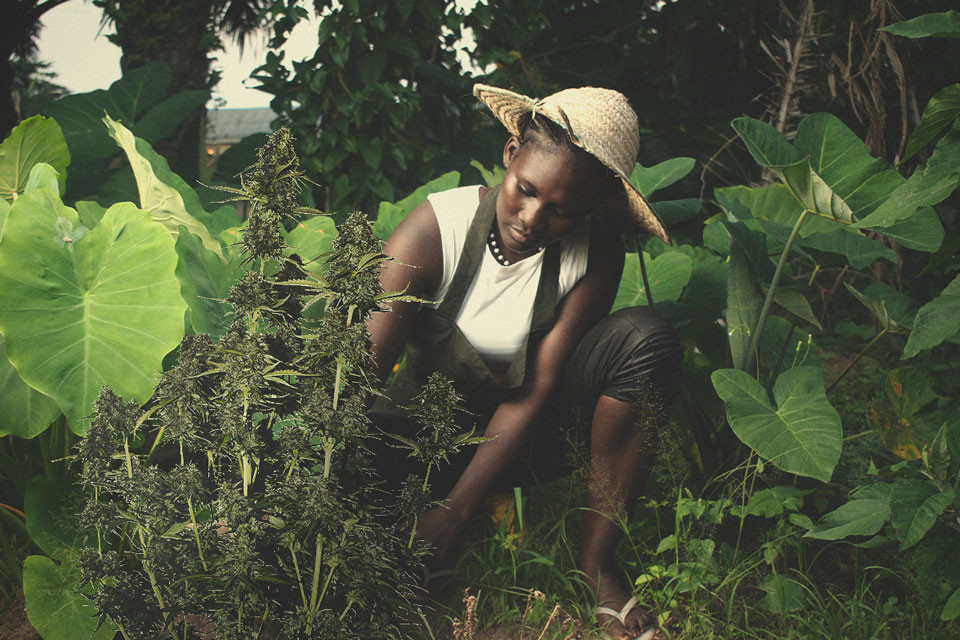.

Cannabis in Lebanon
Cannabis is a rich species of plant that offers a wealth of possibilities when you look across the globe.
Key Points
- Cannabis overfertilization occurs when plants receive excessive nutrients.
- Over time, overfertilization can result in salt buildup in the soil, root damage, and stunted growth.
- Discover the key symptoms and causes of overfertilization here.
- Learn how to treat this condition and how to prevent it from happening again.
Growing healthy cannabis plants requires the right balance of nutrients. However, it’s easy for growers, especially beginners, to fall into the trap of overfertilization.
When your plants receive more nutrients than they can absorb, it can cause stunted growth, nutrient lockout, and reduced yields. Understanding why this happens and how to prevent it is crucial for successful cannabis cultivation.
This guide will explore the causes of cannabis overfertilization, how to diagnose it, and practical steps to fix and prevent it.
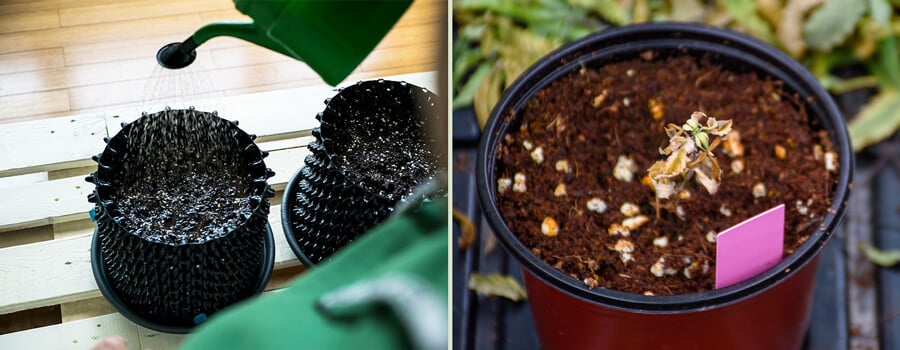
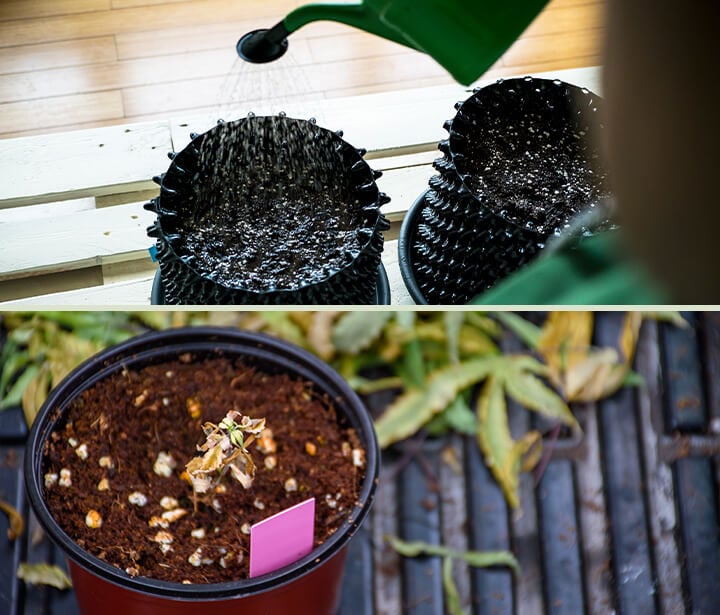
What Is Overfertilization and Why Is It a Problem?
Cannabis overfertilization occurs following the application of excess quantities of a specific synthetic fertilizer. This results in a buildup of ionic salts in the soil or hydroponic medium, resulting in detrimental conditions such as root damage and stunted growth.
Weed plants require an array of different macronutrients and micronutrients to help them fulfil physiological functions throughout all stages of the growing cycle. However, the demand for these substances changes depending on the stage of maturity.
While applying too little of the right nutrient at the right time can cause issues, applying too much can also negatively impact plant health, growth, and yield.
How Overfertilization Differs From Nutrient Burn
The terms cannabis overfertilization and nutrient burn are often mistakenly used interchangeably among cultivators. While closely related, these two conditions have unique attributes that make them distinct.
Overfertilization typically occurs over longer periods and results from a skewed nutrient feeding regimen. Applied regularly, slightly elevated levels of synthetic nitrogen, for example, can cause salt to build up in the growing medium.
This buildup can then cause issues with pH and nutrient absorption, causing plants to eventually exhibit signs of toxicity such as excessively dark green leaves, stunted growth, wilting, and leaf curling.
Nutrient burn, on the other hand, is more of an acute condition. It occurs following the abrupt application of high levels of synthetic fertilizers. This “overdose” results in direct chemical damage to plant foliage, typically manifesting as yellowing, browning, and burned and crispy leaves.
Factor | Overfertilization | Nutrient Burn
Cause | Chronic excessive feeding | Acute nutrient overdose
pH & EC levels | Imbalance | Usually too high
Symptoms | Stunted growth, salt deposits | Leaf tips turning brown
Solution | Flush medium, adjust feeding | Reduce nutrients, flush
Most Common Causes of Overfertilization in Cannabis
Applying too much of a particular fertilizer is the main cause of cannabis overfertilization. However, the cause of the condition ultimately hinges on several different variables.
Continue reading to discover the main causes of overfertilization in weed plants. Get familiar with these factors, and you’ll know exactly where you’re going wrong if you ever encounter the symptoms of overfertilization.
Excess Fertilizer Concentration
Many beginner growers mistakenly believe that more nutrients always equates to faster growth, stronger plants, and bigger buds. While nutrients certainly drive plant growth and development, excess levels do far more harm than good.
Applying excess fertilizer to the soil can occur for several reasons, including simply being overly keen as a novice. Pouring too much feed onto the soil can also result from other innocent errors, such as misinterpreting nutrient guidelines or using concentrated fertilizer without diluting it before application.
Incorrect Nutrient Schedule for Stage of Growth
Cannabis overfertilization also occurs when applying what would otherwise be a healthy amount of fertilizer during the wrong stage in the growing cycle. For example, the amount of nitrogen needed to fuel growth during veg will overfertilize seedlings and flowering plants.
Check out this general guide to fertilization during each stage of growth:
Growth Stage | N (Nitrogen) | P (Phosphorous) | K (Potassium) |
Seedling | Low| Low | Low | Apply only pH-balanced water to avoid burning young roots
Vegetative | High | Medium | Medium | High levels of nitrogen fuel leafy growth
Flowering | Low | High | High | Higher levels of P & K assist flower development
Later Flowering | None | None | None | Withhold all nutrients to flush plants
pH & EC Mismanagement
pH and electrical conductivity (EC) levels play a crucial role in nutrient uptake. When these factors are imbalanced, it can lead to overfertilization by causing nutrient lockout or excessive nutrient absorption.
If the pH is too high or too low, certain nutrients become unavailable to the plant, leading growers to add more fertilizer unnecessarily. While some nutrients remain locked out, plants can absorb those that remain accessible in excess quantities.
On the other hand, high EC levels indicate an excess of dissolved salts, which can create toxic conditions for the roots, further exacerbating nutrient imbalances. Regularly testing and adjusting pH and EC levels helps to prevent overfertilization before it becomes a problem.
To keep track of pH, use a pH meter and measure regularly. Adjust with pH up and down products to hit the sweet spot of your growing medium.
Medium | Optimal pH
Soil | 6.0–7.0 | 1.2–2.0
Hydro | 5.5–6.5 | 1.0–2.0
Use a digital meter to accurately measure EC. Adjust EC by diluting with pure water when levels are too high, or by adding nutrients when levels are too low.
Growth Stage | Soil EC (mS/cm) | Hydro EC (mS/cm)
Seedling/clone | 0.6–1.0 | 0.4–0.8
Vegetative stage | 1.2–1.8 | 1.0–1.6
Early flowering | 1.4–2.0 | 1.6–2.0
Mid flowering | 1.6–2.2 | 1.8–2.2
Late flowering (flushing) | 0.6–1.2 | 0.6–1.0
Issues with Synthetic vs Organic Fertilizers
While synthetic fertilizers work faster in the soil to achieve the desired results, they also are much more likely to cause symptoms of overfertilization when handled incorrectly.
Because they’re delivered in the form of ionic salts, they’re absorbed almost instantly by plant roots. This mechanism has serious advantages, including quickly remedying nutrient deficiencies. However, adding even a bit too much synthetic fertilizer forces plants to uptake more nutrients than they can handle.
Adding to this, synthetic fertilizers disrupt the natural balance of the soil. They irritate, harm, and even kill beneficial organisms such as worms, bacteria, and fungi, which are responsible for building soil structure and cycling nutrients naturally.
Conversely, organic fertilizers aren’t immediately accessible to plants. Instead, they must first be broken down by the beneficial creatures that make up the soil food web. This not only increases soil quality and fertility over time, but the slower release of nutrients practically erases the risk of cannabis overfertilization.
Opt for organic fertilizers where possible. Effective options include liquid seaweed, fish emulsion, and Korean natural farming (KNF) inputs.
How to Identify Overfertilization in Your Cannabis Plants
Cannabis plants can exhibit lots of different symptoms for lots of different reasons. So, how can you go about telling the signs of overfertilization apart from those of insect attacks, diseases, and nutrient deficiencies? Find out how to identify marijuana overfertilization below.
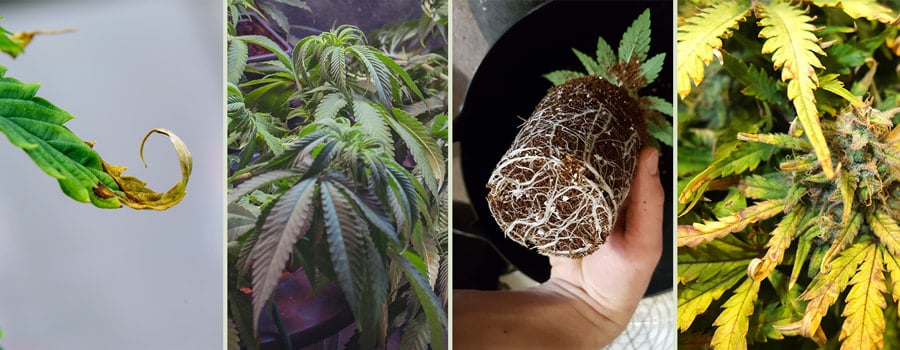
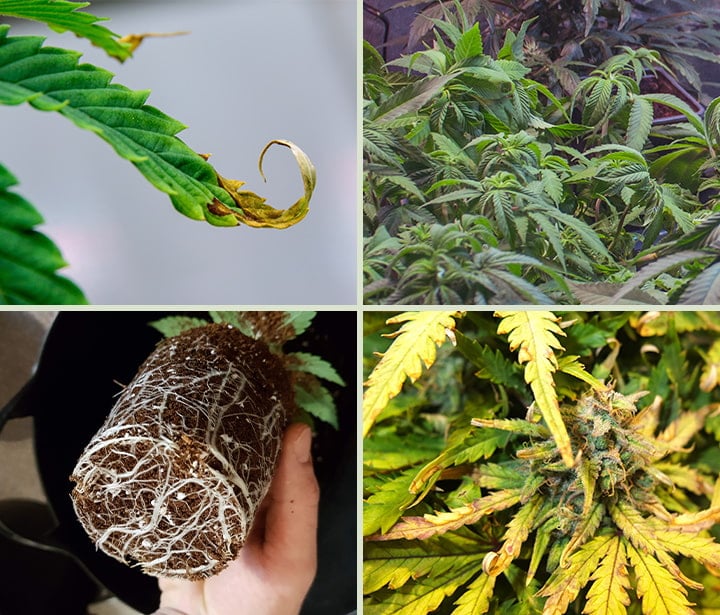
Signs of Overfertilization in Cannabis
The key signs of cannabis overfertilization include:
- Leaf curling: Excess nitrogen can cause leaves to curl downwards, giving them a claw-like appearance.
- Dark green leaves: Too much nitrogen gives cannabis leaves an overly dark green appearance alongside a shiny and waxy look.
- Bronze patches: Excess phosphorus in the soil can cause leaves to become yellow with potential bronze patches across the canopy.
- Brown spotting: After applying too much potassium, cannabis fan leaves often develop brown spots alongside scorched edges.
- Stunted growth: By interfering with plant processes and damaging foliage, overfertilizing ultimately stunts growth and reduces productivity.
- Leaf drop: In extreme cases, prolonged overfertilization can cause damage to leaves, causing them to drop from the canopy.
- Discoloured roots: In hydroponic systems where roots are visible, you’ll see them take on hues of brown and black in cases of overfertilization.
The Role of pH & EC Levels in Diagnosis
As discussed, both pH and EC can serve as potential indicators of cannabis overfertilization. Follow the simple steps below to obtain figures and compare them to the table displayed above.
Sample Collection
To begin, you’ll need to collect a runoff sample. If you’re growing in soil, take a pinch of soil around 3 cm below the surface, close to the roots, and dilute it at a 1:1 ratio with distilled water. If you’re growing hydroponically, simply collect a sample directly from the reservoir.
Measure pH
Follow the simple steps below to get a pH reading:
- Calibrate your pH meter.
- Insert the meter into your sample.
- Take a note of the reading.
- Apply pH up or down products as needed.
Measure EC
Measuring EC involves similar steps:
- Calibrate your Pocket EC Tester.
- Simply place the measurement end of your meter into your sample.
- Take note of the reading on the meter’s screen.
- Apply nutrients or dilute your hydroponic solution accordingly.
Fixing Overfertilization in Cannabis — Step-by-Step Guide
After encountering the symptoms of overfertilization and making an accurate diagnosis, you’ll need to take the necessary steps to return balance to your soil or hydroponic growing medium. Check out the strategies below to make things right.
- Step 1: Flushing Soil
- First things first—you’ll need to flush your soil. This technique simply involves administering large quantities of water to the growing medium to remove excess salts.
To flush effectively, you’ll need to apply three times the amount of pH-adjusted water compared to the pot size. For example, after adjusting the pH to 6.0, gradually apply 30 l of water to a 10 l pot. - Step 2: Repotting
- Sometimes, flushing isn’t enough to dislodge large amounts of salt deposits from the soil. If cannabis overfertilization symptoms persist, you’ll need to repot your plants.
Transfer them into fresh and unfertilized soil. Adjust your feeding regimen and adhere to the recommended doses mentioned on your product of choice. - Step 3: Using Enzymes & Microorganisms for Soil Recovery
- Applying beneficial microbes can also help to recover soil from salt buildup. Applying lactic acid bacteria, for example, can help to break down excess nutrients in the soil.
Likewise, the application of botanical products can also help to clean things up. Aloe vera extract, for instance, can help to speed up plant metabolism, helping specimens use up excess nutrients quicker.
Finally, adding mycorrhizal fungi can help with plant recovery after soil issues are resolved. These friendly microbes team up with plant roots, helping to regulate nutrient uptake.
How to Prevent Overfertilization in the Future
After correcting cannabis overfertilization, there are several steps you can take to avoid having to face this issue again in the future. Check out the prevention tips below to keep your grow streamlined and productive.
Correct Nutrient Schedule & Dose Adjustment
The primary preventative measure for avoiding cannabis overfertilization won’t come as a surprise; it simply involves not adding excess nutrients to your growing medium to begin with!
Although not always as easy as it sounds, following product instructions as closely as possible will help you stay within the safe limits of application. Beginners are also advised to start out applying just 50% of the recommended dose before making adjustments. Check out the reference table below for general guidance:
Week | Nitrogen (N) | Phosphorus (P) | Potassium (K)
1–2 (seedling) | Low | Low | Low
3–5 (veg) | High | Medium | Medium
6–8 (pre-flowering) | Medium | High | High
9–12 (flowering) | Low | High | High
Best Soil for Balanced Nutrient Uptake
Using healthy and microbially active soil will help to reduce instances of overfertilization. Building soil rich in sources of organic matter, such as compost and worm castings, will improve the structure and nutrient-holding capacity of your growing medium.
But building living soil doesn’t stop there. The application of probiotics such as lactic acid bacteria will help to slowly break down the nutrients within organic matter and liquid fertilizers such as seaweed and fish emulsion.
Rather than blitzing your soil constantly with synthetic salts, this holistic approach improves soil and plant health over time, all while minimising instances of overfertilization.
Regular pH & EC Monitoring
Test pH and EC regularly to prevent overfertilization before symptoms appear. Make it a part of your weekly schedule to get a reading on both of these variables. Catching fluctuations early will enable you to act quickly and intervene before any symptoms begin to emerge.
Keeping Cannabis Plants Healthy with Proper Nutrient Management
By understanding and managing overfertilization, you can grow healthier, more productive cannabis plants. The key lies in balanced nutrient schedules, careful pH and EC monitoring, and the use of high-quality soil and fertilizers. Follow these guidelines to keep your cannabis thriving and yield the best results possible!



























